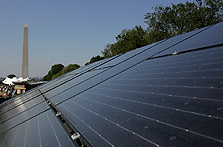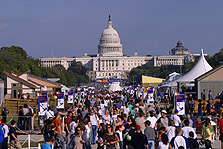

Solar panels in the village drink up some sun.
(Credit: Stefano Paltera, Solar Decathlon)

Build it and they will come.
(Credit: Stefano Paltera, Solar Decathlon)
Solar Decathlon 2005
Daily Journal — October 15, 2005
Decathletes awoke this morning to a cloudless sky, allowing the first rays of sunshine we have seen in more than a week to dapple solar panels and brighten facades along Decathlete Way. The sun's timing is bitter sweet, but none among the village's solar aficionados are bemoaning the beauty of this fine Saturday. With the fiercely competitive competition behind them, students have a little free time now to visit each other's houses and take a look at what everyone else has done, trading notes, stories, and information. As they continue to open their houses to the Saturday crowds of visitors, the village has a slightly more relaxed feel today. Students sit on their porches playing guitars in the sunshine, and chatting with visitors, relishing the aftermath of a very successful competition. A celebration seems in order, so tonight we will gather all the members of the village together in one place for dinner and announcements of special awards at a victory reception.
Several contests and contest components have been announced this past week. And yesterday we announced the overall winners. But there are still several teams who achieved significant accomplishments in several contests. I would like to give them special recognition. Results of all as of yet unreported contests are below.
- For the Comfort Zone Contest, houses had to perform well by maintaining a narrow range of temperature and relative humidity. They were also judged by experts in heating and cooling regarding their delivery of comprehensive thermal comfort, and indoor air quality. The judges placed Cornell University in first place, Cal Poly in second, and the University of Texas in third.
- To earn points in the Contest, teams had to do all the things we do at home. They had to keep their refrigerators and freezers running, prepare and cook meals, do laundry, and operate a TV and computer. Performing well in this contest required excellent energy management. Cal Poly won the Appliances Contest, Cornell placed second, and Colorado third.
- For the Hot Water Contest, teams had to perform several "shower tests," providing at least 15 gallons of water at at least 110° F in 15 minutes or less. They were also judged by experts in solar hot water systems regarding the engineering of their hot water systems. Colorado won the Hot Water Contest, with Cal Poly taking second place, and Cornell placing third.
- For the Lighting Contest teams had to meet specific lighting levels using as little energy as possible. They were also judged by experts in lighting design. Cal Poly placed first in Lighting, Cornell took second, and Universidad Politécnica de Madrid placed third.
- The Energy Balance Contest challenged teams to produce electricity from their solar "photovoltaic" panels and to store that energy in their battery systems. You can imagine this contest presented a significant challenge this past week. Three teams tied for first place. They all ended the competition with as much or more energy stored in their battery systems as when they began the competition. The three teams tied for first place are: Crowder College, Florida International University, and The University of Missouri-Rolla and Rolla Technical Institute.
Thanks to all of their teams for making the Solar Decathlon happen. The houses will be open one more day, tomorrow (Sunday, Oct. 16) from 9 a.m. to 6 p.m.
Reporting from the village,
Richard King, Department of Energy
